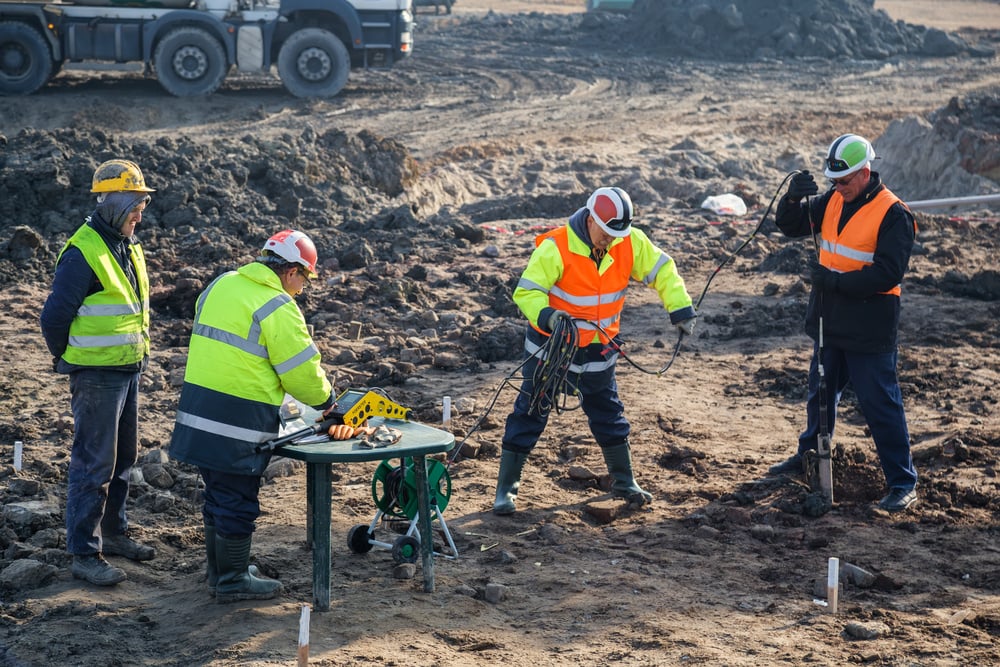Some Known Details About Geotechnical Engineering For Construction Projects
Some Known Details About Geotechnical Engineering For Construction Projects
Blog Article
How Geotechnical Engineering For Construction Projects can Save You Time, Stress, and Money.
Table of ContentsSome Known Factual Statements About Geotechnical Engineering For Construction Projects Not known Details About Geotechnical Engineering For Construction Projects Excitement About Geotechnical Engineering For Construction ProjectsThe Greatest Guide To Geotechnical Engineering For Construction ProjectsThe 9-Minute Rule for Geotechnical Engineering For Construction ProjectsThe smart Trick of Geotechnical Engineering For Construction Projects That Nobody is Discussing
The duty of geotechnical design significantly deals with understanding the features of dirt and rock, which may vary considerably by their thickness, wetness content etc. These attributes need to be taken a look at by geotechnical designers to anticipate their movements under various scenarios. The security in addition to stability of structures are influenced by dirt conditions, making this analysis essential.A geotechnical designer will certainly analyze soil to identify the bearing capability of the planet and suggest proper foundation kinds, such as superficial structures, deep foundations like heaps, or specialized services like floating structures for soft soils. Recognizing the attributes and actions of dirt and rock, in addition to just how they engage with buildings that have actually been erected on or within them, is just one of the key descriptions for why geotechnical engineering is necessary.
Ecological protection is completed via geotechnical design. Know-how in air, water, and dirt quality upkeep is put to use by geotechnical designers to lessen the negative results of jobs.
To sum up, geotechnical engineering is a vital discipline that preserves the strength and integrity of civil framework. Geotechnical engineers contribute to making building tasks effective all over the world by recognizing the behavior of earth products and using ideal preparation techniques.
How Geotechnical Engineering For Construction Projects can Save You Time, Stress, and Money.
The fundamental security of any kind of job is imperative. Geotechnical design plays an important duty in making sure that frameworks are constructed on solid ground, actually and figuratively. By examining soil, rock, and subsurface problems, geotechnical designers provide important understandings that aid in the style, building and construction, and maintenance of structures and framework.

The smart Trick of Geotechnical Engineering For Construction Projects That Nobody is Discussing
Laboratory testing: Establishing the homes of soil and rock. Numerous prominent building and construction jobs have efficiently made use of geotechnical engineering to guarantee their stability and security.

As a leader in geotechnical engineering, BECC Inc. is devoted to providing cutting-edge and effective solutions that fulfill the highest possible standards of quality and safety and security. For more information on just how BECC Inc. can support your following building job, call us today and let us assist you improve strong ground.
William Rankine, an engineer and physicist, established an alternative to Coulomb's earth pressure theory. Albert Atterberg developed the clay consistency indices that are still utilized today for soil classification. In 1885, Osborne Reynolds recognized that shearing reasons volumetric dilation of dense materials and contraction of loosened granular materials. Modern geotechnical engineering is stated to have actually started in 1925 with the magazine of Erdbaumechanik by Karl von Terzaghi, a mechanical designer and rock hound.
5 Simple Techniques For Geotechnical Engineering For Construction Projects
Terzaghi also established the structure for concepts of birthing capacity of foundations, and the concept for prediction of the rate of negotiation of clay layers as a result of consolidation. Afterwards, Maurice Biot fully top article created the three-dimensional soil loan consolidation concept, extending the one-dimensional version formerly developed by Terzaghi to a lot more general hypotheses and presenting the set of basic formulas of Poroelasticity.
Geotechnical designers examine and identify the residential properties of subsurface conditions and products. They also develop corresponding earthworks and preserving structures, passages, and structure foundations, and may manage and examine sites, which may better entail site monitoring as well as the danger evaluation and reduction of all-natural risks - Geotechnical Engineering for Construction Projects. Geotechnical engineers and design geologists perform geotechnical examinations to get info on the physical residential or commercial properties of soil and rock underlying and beside a website to develop earthworks and structures for proposed structures and for the fixing of distress to earthworks and frameworks caused by subsurface problems.
Some Known Questions About Geotechnical Engineering For Construction Projects.
Still, they are in some cases utilized to allow a geologist or engineer to be reduced into the borehole for direct visual and hand-operated evaluation of the soil and rock stratigraphy. Different soil samplers exist to fulfill the demands of different design projects. The common penetration test, which uses a thick-walled split spoon sampler, is one of the most typical way to accumulate disrupted examples.

Typically, the user interface's specific geometry is unknown, and a streamlined interface geometry is thought. Finite inclines call for three-dimensional versions to be analyzed, so most inclines are analyzed presuming that they are infinitely wide and can be stood for by two-dimensional versions.
Geotechnical Engineering For Construction Projects Fundamentals Explained
The empirical method may be described as adheres to: General expedition sufficient to establish the rough nature, pattern, and buildings of deposits. Analysis of one of the most probable conditions and one of the most negative imaginable variances. Developing the design based upon a working theory of actions expected under the most probable conditions. Option of amounts to be observed as construction earnings and computing their expected worths based upon the working hypothesis under one of the most unfavorable conditions.
Measurement of amounts and analysis of actual conditions. Design explanation adjustment per real problems The empirical approach is appropriate for building and construction that has actually already started when an unanticipated growth takes place or when a failure or accident looms or has actually currently taken place. It disagrees for projects whose design can not be modified throughout construction.
Report this page